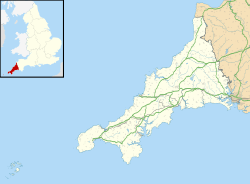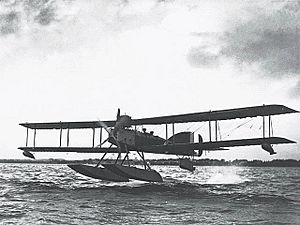RNAS Tresco facts for kids
Quick facts for kids RNAS Tresco
|
|
|---|---|
| Near Tresco, Isles of Scilly, Cornwall in England | |
|
Shown within Cornwall
|
|
| Coordinates | 49°57′12″N 6°20′17″W / 49.95333°N 6.33806°W |
| Type | Royal Naval Air Station |
| Site information | |
| Owner | Royal Navy |
| Operator | Royal Navy |
| Site history | |
| Built | 1917 |
| In use | 1917-1919 |
RNAS Tresco was a special base for the Royal Naval Air Service. It was located on Tresco, the second biggest island in the Isles of Scilly. From February 1917 to May 1919, planes from this base flew over the Western Approaches. Their main job was to protect ships traveling in groups called convoys. These planes spotted 13 enemy submarines, known as U-boats, and attacked nine of them.
Contents
History of RNAS Tresco
In January 1917, some Short Type 184 seaplanes arrived at Porthmellon. This was on St Mary's island. Local people had warned that the bay was too open for these delicate planes. Soon after, several Curtiss Type 12 flying-boats joined them. These came from RNAS Cattewater near Plymouth.
Moving to Tresco
Before the base was fully ready, it was moved to Tresco. It was set up at a place called New Grimsby. This new base became known as RNAS Tresco.
First Patrols and Attacks
The first patrol flight happened on February 28, 1917. The first important action took place on May 27, 1917. A U-boat was seen on the surface near Bryher island. Before diving underwater, the U-boat shot at the plane. It hit the plane's radiator, making a hole.
One of the brave crew members climbed onto the wing to fix it! They used a handkerchief to plug the hole. The flying-boat then dropped two bombs. People watching from the shore saw the submarine's back end rise out of the water. It went up at a steep angle before it sank. Later research suggests the U-boat might have survived. The crew of the Curtiss Type 12 plane were later given awards for their bravery.
Full Operations and Achievements
By the summer of 1917, the base had all its facilities ready. From August, there were about 22 planes stationed there. These included Short Type 184 and Felixstowe F.5 flying-boats. The squadron flew patrols over the Western Approaches of the English Channel.
The pilots and crew earned several awards for their courage. They received two DSCs, one DSM, and a CGM. They also stopped U-boat attacks on important ships. One notable event was when they helped protect the White Star liner, Persic. The Persic was damaged but managed to reach port safely thanks to their help.
Becoming No. 234 Squadron RAF
On August 18, 1918, the unit changed its name. It became No. 234 Squadron, RAF. They used Short Type 225 seaplanes at this time. The very last patrol flight from the base was on November 10, 1918. By then, all four groups of planes had joined the RAF as No. 234 Squadron RAF. The base was officially closed down in May 1919.
What Remains Today
Some parts of RNAS Tresco can still be seen today. The most noticeable part is the ramp that led from the yard down to the beach. The area where the base once stood is now home to the Flying Boat Club of the Tresco Estate. This name is a nice nod to the flying-boats that used to be there!



